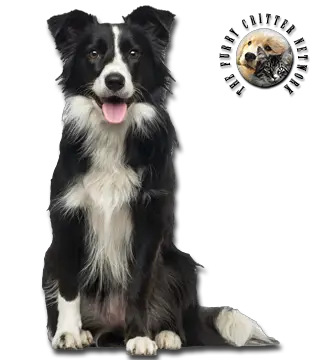Breed Standard
Head: Moderately long skull. Strong, relatively short muzzle. Distinct stop. Black, brown, or dark gray nose, according to coat color.
Ears: Medium size, set well apart, and carried erect or semi-erect.
Eyes: Oval, set well apart. Brown color except for merles, which may have blue eyes.
Body: Well-balanced and athletic. Strong neck. Ribs well sprung. Muscular loin. Moderately broad chest, well let down.
Tail: Moderately long. Set low, curving slightly up at the tip.
Hair: There are two varieties, the rough coat, which has a mane, culottes, and fox tail (brush), and the smooth coat. In both varieties, the coat is dense and of medium texture; dense, soft undercoat.
Coat: Generally pied, with white collar, blaze, and socks, with the remainder of the coat being black. All colors permissible, but white must not be the dominant color.
Size: Dog: 50 to 55 cm.Bitch: 47 to 52 cm.
Weight: 15 to 20 kg.
Height at withers: Males from 19" to 22", females from 18" to 21". (See various breed standards for details.)
History
It is thought that the Border Collie's ancestors are Nordic breeds that guarded reindeer herds. When they arrived on the British Isles with the Vikings, they were crossed with local sheepdogs. The Border Collie was named after the region where the breed was developed, the hilly border country between England and Scotland. The most common of the collies, the Border Collie still has the same duties today as he did in the eighteenth century, guarding the herd. The breed was not standardized until the nineteenth century. It was recognized by the Kennel Club of England in 1976 and by the Canadian Kennel Club in 1985. The Border Collie was introduced in France in 1970.
Behavior
The Border Collie is an extremely intelligent, biddable breed with an instinctive desire to work closely and intensely with a human handler. Although the primary role of the Border Collie is that of the working stock dog, dogs of this breed are becoming increasingly popular as pets. True to their working heritage, Border Collies make very demanding, energetic pets that are better off in households that can provide them with plenty of exercise and a job to do. Among some breeders in the United Kingdom there is a common saying: "no sheep, no collie", referring to the dog's usual unsuitability to people who just want a "smart dog." However, in an appropriate home, with a dedicated, active owner, a Border Collie can be an excellent companion. Participating in dog sports is popular with Border Collie owners.
Border Collies are unsuitable pets for people who cannot or will not provide a considerable amount of daily exercise for their dogs, both physical and mental. They are also a poor choice for households that are not prepared for the characteristic behaviors that are part of their working heritage. For example, as with many working breeds, Border Collies can be motion-sensitive and may attempt to control the movements of family members, cats, squirrels, bicycles, cars, or anything else that moves if not given enough mental and physical stimulation. These dogs are also not suitable for households with small children, because they frequently try to "herd" the children or react rather quickly to unexpected movements. Many Border Collies who end up in shelters or rescue groups are there because owners, who may have been attracted by their appearance and intelligence, were not prepared to meet their dog's needs.
Matt Bryant (Furry Critter Network), We had Border Collies at our farm when we were rehabing rescue horses. This is Layla. We had one litter of puppies with her and ended up giving two of the puppies to neighbors, and keeping the rest. Beautiful breed and very loyal. The level of intelligence is remarkable. They were a joy to work and play with. We were very attatched to all of them.
Function
Herder, Pet.
Health
Hip dysplasia, Collie eye anomaly (CEA), and epilepsy are considered the primary genetic diseases of concern in the breed at this time. Collie eye anomaly (CEA) is a congenital, inherited eye disease affecting Border Collies and other breeds involving the retina, choroid, and sclera. In Border Collies, it is generally a mild disease and rarely significantly impairs vision. There is now a DNA test available for CEA and, through its use, breeders can ensure that they will not produce affected pups. There are no genetic tests available for hip dysplasia or epilepsy, although careful breeding practices are known to lower the incidence of both.
Elbow dysplasia or Osteochondritis, deafness, and hypothyroidism may also occur in the breed. Dogs homozygous for the merle gene are likely to have eye and/or hearing problems. Responsible breeders do not mate merles to one another.
Neuronal ceroid lipofuscinosis (NCL) is a rare but serious disease. NCL results in severe neurological impairment and early death; afflicted dogs rarely survive beyond two years of age. The mutation causing the form of the disease found in Border Collies was identified by Scott Melville in the laboratory of Dr. Alan Wilton of the School of Biotechnology and Biomolecular Sciences, University of New South Wales, Sydney, Australia. There is no treatment or cure, but a DNA test is now available to detect carriers as well as affected dogs.
Trapped Neutrophil Syndrome (TNS) is a hereditary disease which inhibits the release of neutrophils produced in the bone marrow into the blood stream. Puppies affected with this disease will eventually succumb to infection. Because this is an autoimmune-deficiency disease the puppies present a variety of symptoms depending upon what infections they fall susceptible to, and so it has gone undiagnosed in the past. Once thought to be rare, it is now believed to be responsible for many cases of "fading puppies". There is no cure, but a DNA test is now available to detect carriers as well as affected dogs. Please visit the American Border Collie Association for more information.







